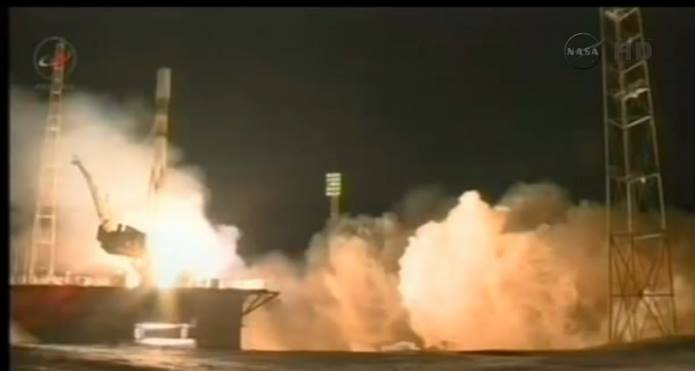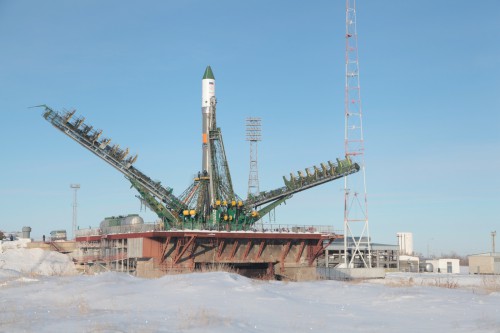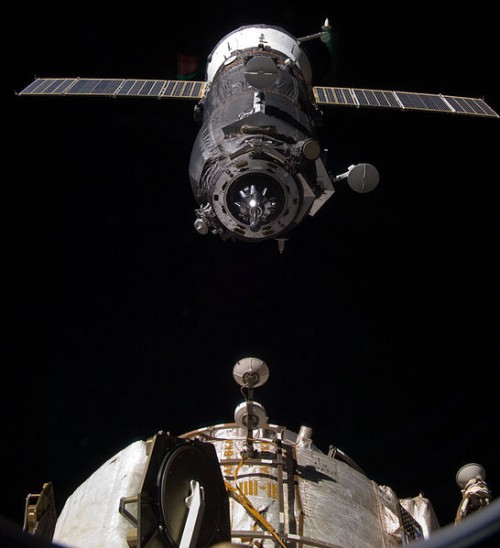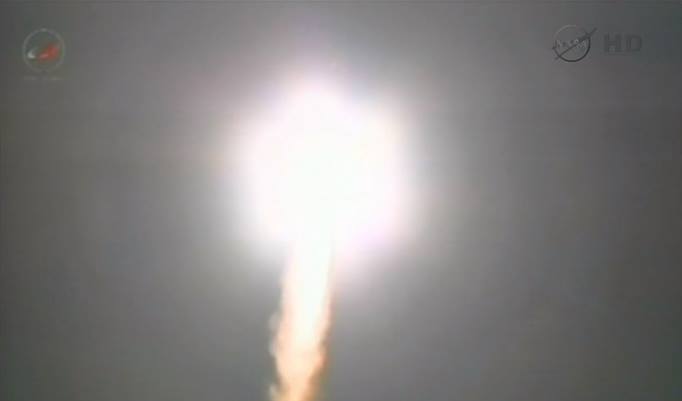
Russia has successfully launched its 54th Progress resupply craft to the International Space Station (ISS), carrying 5,600 pounds (2,540 kg) of payloads, supplies and consumables to the incumbent Expedition 38 crew. Liftoff of Progress M-22M—also known as “Progress 54P” in ISS Program-speak—from Site 1/5 at the Baikonur Cosmodrome in Kazakhstan took place on time at 10:23:30 p.m. Baikonur time (11:23:30 a.m. EST) Wednesday, 5 February. At the time of writing, the spacecraft had successfully separated from the third and final stage of its Soyuz-U rocket and was beginning a now-standard six-hour, four-orbit “fast rendezvous” profile to reach the ISS.
Processing of this mission has gone exceptionally smoothly, and the tanks for Progress’ maneuvering thrusters were loaded with nitrogen tetroxide and unsymmetrical dimethyl hydrazine propellants and high-pressure helium. Last week, the spacecraft was transferred to Baikonur’s Launcher Integration Building for installation atop the Soyuz-U rocket—a direct descendent of Sergei Korolev’s R-7 missile—and following approval from the customary Russian Government Commission the complete vehicle was rolled out to the Site 1/5 launch complex on Monday, 3 February. Transported to the pad horizontally, it was later raised to a vertical configuration, enabling the connection of electrical and propellant umbilicals as technicians prepared for battery charging and fueling operations.
Fueling with liquid oxygen and rocket-grade kerosene (known as “RP-1”) got underway about five hours before today’s liftoff and transitioned into a topping-off mode, whereby all cryogenic boil-off was rapidly replenished. This ensured that the liquid oxygen tanks were maintained at Flight Ready levels, ahead of the ignition of the single RD-118 first-stage engine and the RD-117 engines of the four tapering strap-on boosters. By 9:50 p.m. Baikonur time (10:50 a.m. EST), according to AmericaSpace’s Launch Tracker, the servicing tower had been retracted from the Soyuz-U vehicle. “The rocket is now exposed on the launch pad,” the Tracker noted. “The fueling and power arm is still attached to the rocket, as are the clam-style hold downs on the base.” It was a cold night on the desolate steppe of Kazakhstan, with temperatures reaching as low as -21 degrees Celsius (-6 degrees Fahrenheit).

In the final minutes of the countdown, internal avionics were initiated and the on-board flight recorders were spooled-up to monitor the vehicle’s myriad systems. At T-10 seconds, the turbopumps on the core and strap-on boosters came to life and the engines were confirmed to be running at full power, producing a retraction of the fueling tower and a perfect, on-time launch into the darkened Baikonur sky. Fifteen seconds after liftoff, as noted by AmericaSpace’s Launch Tracker, a pitch and roll maneuver was completed, placing the vehicle onto the correct trajectory to insert Progress M-22M into orbit.
Rising rapidly, the vehicle passed 1,100 mph (1,770 km/h) within a minute of liftoff, during which time the maximum amount of aerodynamic stress (known as “Max Q”) impacted the vehicle’s airframe. At T+118 seconds, at an altitude of about 28 miles (45 km), the four strap-on boosters exhausted their supply of liquid oxygen and rocket-grade kerosene (RP-1) and were jettisoned, leaving the central core and its single engine to continue the ascent. By two minutes into the flight, the rocket was traveling at over 3,350 mph (5,390 km/h). The payload shroud and escape tower were jettisoned shortly afterward, and, some four minutes and 47 seconds after leaving Baikonur, the core separated at an altitude of 105 miles (170 km) and the RD-0110 engine of the third and final stage ignited to boost Progress M-22M to a velocity in excess of 13,420 mph (21,600 km/h). By the time the third stage separated, nine minutes into the flight, at 10:32 p.m. Baikonur time (11:32 a.m. EST), the vehicle was in space.
Separation of Progress M-22M took place into a target orbit of approximately 120 x 152 miles (193 x 245 km), inclined 51.66 degrees to the equator, and the process of unfurling its solar arrays and Kurs-NA (“Course”) rendezvous and navigation appendages got underway. “The solar arrays and navigational antennas have now been deployed,” noted AmericaSpace’s Launch Tracker, “and the next step in the mission will be the first of four burns of the Progress engine as it performs the planned maneuvers to rendezvous with the ISS.”
In a manner not dissimilar to several earlier Progress missions and recent piloted Soyuz craft, today’s mission will pursue a six-hour, four-orbit “fast rendezvous” profile to reach the ISS. Docking at the Earth-facing (or “nadir”) port of the station’s Pirs module is presently scheduled to occur at 4:24 a.m. Baikonur time Thursday (5:24 p.m. EST Wednesday) and Progress M-22M will remain in residence until early April. In anticipation of Progress M-22M’s arrival, Expedition 38 Commander Oleg Kotov and Flight Engineer Mikhail Tyurin spent Monday morning conducting a training session with the Telerobotically Operated Rendezvous Unit (TORU), which could be used to remotely guide the unpiloted cargo ship to its docking port in the event that its Kurs-NA automated rendezvous system experiences a problem.

After docking with the Earth-facing (or “nadir”) Pirs module, Progress M-22M will deliver 5,600 pounds (2,540 kg) of supplies to the six-man Expedition 38 crew, which also includes Russian cosmonaut Sergei Ryazansky, U.S. astronauts Mike Hopkins and Rick Mastracchio and Japan’s Koichi Wakata. The supply ship’s pressurized compartment houses 2,740 pounds (1,244 kg) of dry cargo, including systems maintenance hardware, hygiene equipment, food provisions, medical supplies and personal protection and emergency equipment.
It will also carry a payload of goldfish, worms, and mosquito larvae as part of a joint experiment between the Japan Aerospace Exploration Agency (JAXA) and Russia’s Institute of Biomedical Problems. This experiment will focus on skeletal muscle changes and embryonic development of the fish and the cultivation of organisms and regeneration of tissues in the mosquito larvae and worms. The Progress will also deliver 1,450 pounds (660 kg) of propellant for the space station’s tanks. It will remain docked at Pirs until April, after which it will be separated and deorbited in the upper atmosphere.
The preparations for the Progress M-22M launch ran concurrently with the undocking of an earlier cargo craft, Progress M-20M, from Pirs at 12:21 a.m. Baikonur time Tuesday, 4 February (1:21 p.m. EST Monday, 3 February). The latter had been in residence at the ISS since last July and will spend the next few days in autonomous free flight, conducting the Izgib experiment, which seeks to measure micro-accelerations of the spacecraft whilst in different attitudes using on-board accelerometers and gyroscopes. Current plans call for Progress M-20M to be deorbited Tuesday, 11 February.

With the arrival of Progress M-22M at the ISS on Wednesday evening, no fewer than two Progresses will be in attendance at the multi-national laboratory. Another craft, Progress M-21M, was launched in November 2013 and is presently docked at the aft longitudinal port of the Zvezda module, from which it executed a periodic reboost of the space station’s orbital altitude in December. Progress M-21M will perform a second reboost later this month and is expected to undock in mid-April for two days of tests of its new Kurs-NA navigation system. It will then redock and remain at the ISS until mid-June, after which it will separate for the final time and be deorbited. According to the present manifest, Progress M-23M will launch in early April, followed by Progress M-24M in late July and Progress M-25M in late October. These visitors will provide vital support for the five crews—of Expeditions 38 through 42—who will occupy the ISS in 2014.
Progress has a storied history. Its development began in 1973 in response to the anticipated problem of resupplying and refueling the Soviet Union’s Salyut 6 space station, whose cosmonauts went on to spend more than six months at a time in orbit. Modeled closely on the Soyuz spacecraft, its interior was redesigned to house foodstuffs, water, experiments, and fuel for the station’s manoeuvring thrusters. Since its maiden voyage, Progress has seen many changes, but its role has remained largely unchanged … and the numbers speak for themselves. Between its first launch in January 1978 and today’s flight, no fewer than 144 Progresses have roared aloft. Only one has failed to reach its destination: the unlucky Progress M-12M in August 2011, whose launch vehicle suffered an engine malfunction and re-entered the atmosphere over the Altai region.
Want to keep up-to-date with all things space? Be sure to “Like” AmericaSpace on Facebook and follow us on Twitter: @AmericaSpace



